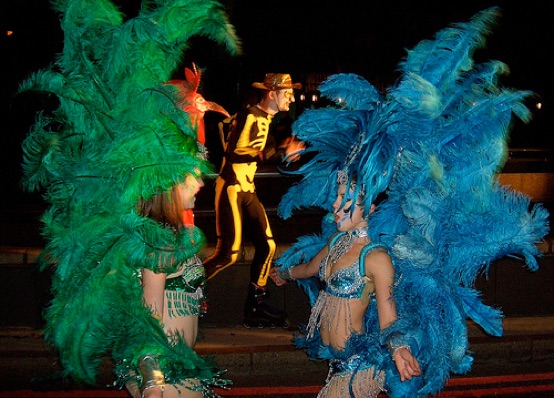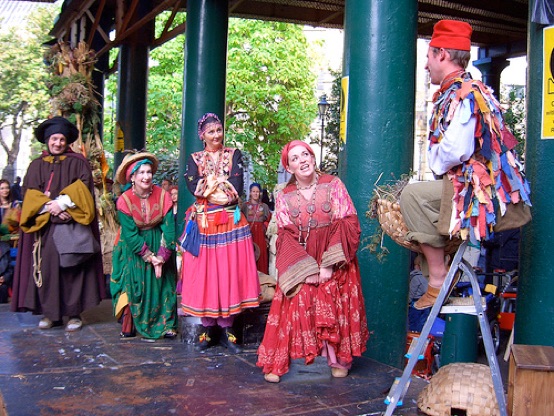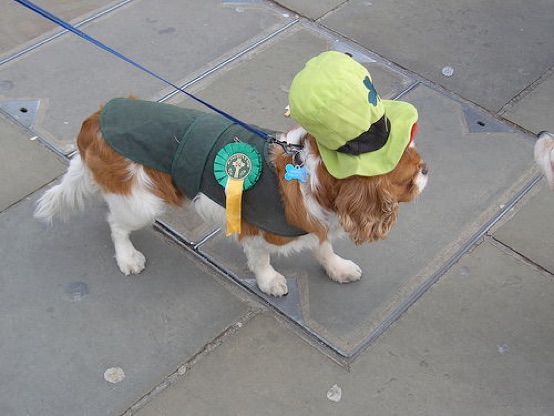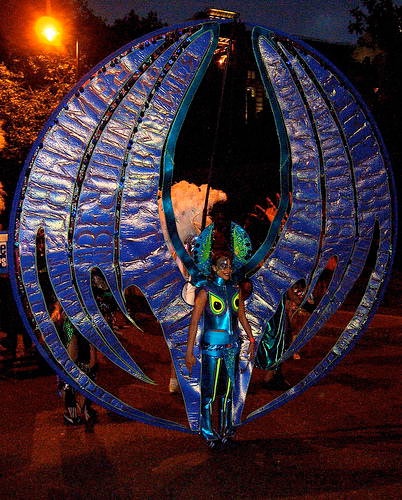from Articles...


Home | A Year of Our Own | Articles | Photography | Bio | Contact
William Baeck: Writing & Photography
A Year of Public Spectacles
in London
for the San Antonio Express-News
New Year’s Eve approaches, and again I’m torn between my need for once-a-year reflection and attending one more party.
Last year was simpler.
I was living in London, and there was no better place that night than our fourth-story rooftop to reflect not just on myself, but on London, which was already partying, judging by the fireworks that created a Technicolor blitz across the city.

South American by way of London, these Carnival ladies
dance past the crowd at the Mayor’s Thames Festival.
The biggest and brightest of these came from south of us, by the River Thames, which bisects London. That was where the official New Year's celebration was being staged.
The centerpiece was the London Eye, a 450-foot-tall “observation wheel” which looks not just roughly, but precisely like it came off an impossibly giant bicycle — hub, spokes and all. Tonight, flames and skyrockets were firing from it as it slowly revolved like a monstrous pinwheel. Londoners have learned this lesson well from their Roman founders: they love their public spectacles.
New Year’s Eve was the night I became convinced that London keeps two sets of English people, the way my mother always kept two sets of dishes: one for everyday use and the other for special occasions.
A festival in London is always a special occasion, and attending one is a chance to see these other English while they celebrate themselves.
You won’t find the reserved, everyday English there, the ones who gather in quiet queues in the Underground, eyes fixed resolutely on the Evening Standard. Festival Londoners are splashy, informal and loud, yet still somehow terribly polite while being so.
Public events occur in London throughout the year and the odds are that if you're visiting for more than a few days, you, too, can find one to attend.
Large celebrations, like the Notting Hill Carnival, can attract half a million guests, while small neighborhood happenings bring in mostly locals.
But from the pageant and pomp of the Lord Mayor's inauguration to the “only in England” eccentricity of an October Plenty festival in the Borough Market, all display a London that is special even by its own standards.
Because living in London costs roughly double what it does in the U.S., our vacation survival instincts had made my wife and I experts at finding free public celebrations and festivals to attend.
The list below shows a sampling of free events during the year. If you have Internet access while you're visiting, the best way to find out what's happening is to check www.londonfreelist.com.
Otherwise, pick up a copy of Time Out magazine, available in nearly every grocery shop and newspaper kiosk in the city.
January
New Year’s Day Parade. The New Year commences with a parade of more than 10,000 performers ranging from dance troupes to pearly kings and queens. And even if you don't recognize any of the giant balloon figures based on European cartoon characters, there's a touch of home in the cheerleaders and marching bands imported specially from the States. Beginning at noon in Parliament Square near Big Ben, the parade moves through the West End of London, ending two miles and three hours later at Berkeley Street.

Friends and family can’t dissuade a foolish husband from trying
to hatch a calf from cheese during the October Plenty Festival.
Twelfth Night. Early January. To mark the end of the Christmas season, the Lions Part acting company presents a medieval pageant beginning at Shakespeare’s Globe Theater on Bankside. Join a procession including a piper, a town crier and the pagan Holly Man (who, not surprisingly, looks like the overfertilized offshoot of a holly tree). The troupe then moves to the Bankside jetty, where it performs a mummer’s play — a rowdy, semi-improvisatory folk play. Stick around for wassails (toasts) to the river and the people, then follow along to the 17th century George Inn, where you can drink some mulled wine and try your feet at Molly dancing.
February
Chinese New Year. Feb. 18 in 2007. If you’re too late for the New Year in January, try the Chinese New Year instead. Also known as the Spring Festival, this event includes dragons in a parade from Charing Cross Road to Trafalgar Square. Previous celebrations have included dragons, acrobats and even a performance by the Peking Opera.
Pancake Day Races. Shrove Tuesday. Yes, it’s pretty much like it sounds. Runners line up at various sites such as Brick Lane, All Hallows Church near the Tower of London, and the Guildhall. Then, pancake in pan, they race down the street, flipping the contents at strategic points along the way. (If this doesn’t satisfy your craving for sprinting with sweets, there’s also the Great Christmas Pudding Race at Covent Garden in December.)
March
St. Patrick’s Day Parade and Festival. Sunday nearest March 17. The city turns green, even before the drinking begins. An Irish-themed parade with 4,000 participants moves from Piccadilly Circus to Whitehall. Meanwhile, Irish bands play for the crowds in Trafalgar Square, Leicester Square and Covent Garden, where there are also Irish crafts and activities. Half the fun is watching the watchers — look for green dog owners walking their green dogs.

Even dogs go green on Saint Patrick’s Day.
London Maze. Saturday, mid-March. For the more sober-minded, the Guildhall in the center of London presents walks and talks about the city's past. Inside are stalls from historical societies such as the Tower Bridge Museum, as well as the towering painted statues of Gog and Magog, the traditional guardians of the city. Before you leave, walk across the square to the Guildhall Art Gallery. In the basement you'll find part of a Roman amphitheater that was unearthed when the gallery was being built in 1988.
April
London Marathon. April 2. This 26.2-mile marathon, fun run and party laid out around the River Thames attracts over 30,000 runners. Live bands and half a million people line the route to cheer on the serious competitors as well as outlandishly dressed fun runners.
St. George’s Day/Shakespeare's Birthday. April 23. Covent Garden is the setting for a festival honoring England's patron saint. Folk dancing and singing are included, along with a Punch and Judy show. April 23 is also the birthday of England’s greatest export, William Shakespeare, so head over to the Globe Theater on the south bank of the Thames for something dramatic. Along with traditional games and food, past activities have included a “best theatrical death” competition and acting workshops. You can even tread the stage while reciting your favorite Shakespeare lines. “Cry God for Harry, England and St. George!”
May
May Fayre and Puppet Festival. Sunday in mid-May. Held in Covent Garden, this festival has folk music, brass bands, traditional dancing, a maypole and of course lots of puppets. There's even a puppet-friendly service at the lovely St. Paul's Church at Covent Garden. Although this little church isn’t quite as impressive as St. Paul’s Cathedral, its location in the heart of the theater district makes it the actor’s church. Be sure to read the memorial plaques of the many famous actors associated with it, from Charlie Chaplin to Vivien Leigh.
Baishakhi Mela. Sunday in mid-May. So you’ve missed New Year in January and the Chinese New Year in February? Well, here’s your chance to celebrate the Bengali New Year held at Brick Lane, one of the most colorful areas in the East End. Stalls selling food, clothing, arts and crafts abound, along with musicians and dancers whose styles range from traditional to Bollywood.

One of the colorful masqueraders at the Mayor’s Thames Festival.
June
Exhibition Road Music Day/Fête de la Musique. Mid-June. Exhibition Road in South Kensington is best known as the address for several of London's biggest museums, including the Natural History Museum and the Victoria and Albert Museum. But in June these institutions and others along Exhibition Road host performances by musicians from around the world celebrating all forms of music. Catch a Brazilian jazz band at the Goethe-Institut or try a drumming workshop with the Royal Philharmonic Orchestra at the Natural History Museum.
Trooping of the Color. June 16. If you're a royal-watcher, join the crowds lining the Mall as they watch the queen watch the Queen's Colour of a Foot Guard battalion celebrate her “official” birthday (as opposed to her real birthday on April 21 — don't ask, this is England after all). Over a thousand officers and enlisted men and women, along with hundreds of musicians, pageantry, shouted orders and lots of saluting.
July
Rise: London United Festival. July 14. This free festival in Finsbury Park fights racism and promotes diversity by presenting a diverse range of musical acts. The music is heavy on the three R’s: rock, reggae and rap, with past participants including Blur, Graham Coxton and The Wailers. In addition to the music, there's a fair, food stalls and play areas for the kids.
City of London Festival. June 25 to July 12. Something for the arts crowd, with music, poetry, film, art — even world premieres — presented in historic buildings within the "square mile" of the City of London.
August
Carnaval del Pueblo. Aug. 5. This Latin American festival typically kicks off with a parade from City Hall in South London and ends in Burgess Park. Expect lots of Rio-inspired exotic costumes, hot Latin dancing, music and food.
Notting Hill Carnival. Last weekend in August plus the following Monday. Notting Hill is the site of what's been described as “the biggest street party in Europe,” with masqueraders, monster sound systems and music ranging from reggae to rap. Saturday includes a competition between steel pan bands, Sunday is Children's Day with a short parade, while Monday has the big parade.
September
London Open House. Saturday and Sunday, mid-September. This is a chance to see what goes on behind London's most interesting closed doors, when the city opens up more than 600 buildings that are normally unavailable to the public. Check out the Royal Courts of Justice, the Long Hall in the Parliament building, the Bank of England, or the tiny, opulent Victorian chapel in the Great Ormond Street Hospital for Children.

The domed ceiling of St. Christopher’s Chapel in the Great Ormand
Street Hospital for Children shines during London Open House.
Mayor's Thames Festival. Sept. 15 and 16. London never runs out of things to celebrate. This time it's the River Thames, as the mayor turns the area between Westminster Bridge and Tower Bridge into a mix of street theater and carnival. The best part is the final night's lantern parade along the Victoria Embankment, with glowing, fantastical floats. Don’t forget to stay for the fireworks.
October
The Pearly Kings and Queens Harvest Festival. Oct. 7. Wearing extravagant pearl button designs emblazoned on black clothes, the pearly kings and queens date back to Victorian times. Nowadays known for their charitable work, pearly families from all over London parade through Trafalgar Square on their way to the Harvest Festival Service at the nearby Church of St. Martin-in-the-Fields.
Diwali. Mid-October. The word means “row of lamps” and is a five-day Hindu, Sikh and Jain festival celebrating the victory of light over darkness. It’s held across London, but one of the best places to experience the dancers, booths, costumes, food and music is at Trafalgar Square on Sunday. And if you don’t see the fireworks that week, you’ll probably hear them throughout the city.
October Plenty. Late October. To celebrate the autumn harvest, the Lions Part acting company leads a floral procession that includes a Corn Queen effigy made of grains, fruits and vegetables, and the Berry Man, a pagan vegetation deity. Starting from Shakespeare’s Globe Theater on the south bank of the Thames, the group gambols several blocks to the outdoor Borough Market, where the performers present a medieval or Elizabethan play. There’s also a special “story orchard” filled with tiny apple trees, where children can listen to tales of the harvest and market.

Two women ponder the pagan Corn Queen
at the October Plenty Festival.
November
Lord Mayor’s Show. Nov. 10. Moments after being inaugurated, the Lord Mayor of the City of London puts on the best parade of the year. Over the next 2-1/2 hours upward of 100 floats and 6,000 participants wind their way from the Guildhall to Temple Place by way of St. Pau’'s Cathedral. It’s an opportunity to watch 800 years of British history walk, march, trot, motor, float and dance past you.

A Pearly King dazzles in his traditional costume.
Bonfire Night. Nov. 5. “Remember, remember the Fifth of November.” So goes the children’s rhyme commemorating Guy Fawkes and company’s unsuccessful attempt to blow up Parliament in 1505. Now, every Nov. 5th, Brits in public parks and communal gardens set bonfires and burn Fawkes in effigy, followed by fireworks. If you see kids with an effigy of Mr. Fawkes, asking “Penny for the Guy?” don’t forget to give them your small change — they use it to buy extra fireworks and candy.
Remembrance Day. Sunday nearest Armistice Day (Nov. 11). Of all the public events, this may be the most moving. The Royal Family leads a wreath-laying ceremony at the Cenotaph in Whitehall followed by a procession of thousands of current members and veterans of the armed forces. Remember to buy a poppy to wear from the Royal British Legion.
December
Caroling at Trafalgar Square. Nightly. Once Norway’s yearly gift of a 70-foot spruce Christmas tree is set up and lit at the end of November, most evenings until Christmas are devoted to caroling in the square. If that’s not enough to warm your heart, try some freshly roasted chestnuts from one of the nearby street vendors.
Frost Fair. Mid-December. Billed as “London's biggest free annual winter event,” this three-day fair is held on the South Bank between the Globe Theater and the Tate Modern art museum. There’s ice-sculpting, rides and food and gift stalls, making it a good opportunity for snacking and strolling your way through Christmas shopping.
New Year’s Eve. There are lots of celebrations going on around the capital, including at Trafalgar Square. But if it’s big fireworks you want, head over to the River Thames and the Millennium Eye — or for a better view, the south bank across from it. If you notice some folks wearing especially unusual outfits, they’re probably on their way to a “fancy dress party,” which is Brit-speak for a costume party. And of course, if you stick around a few more hours, the next day brings the New Year’s Day Parade and a whole new year of public events.
Previous Article | Next Article
© 2010 William Baeck. All Rights Reserved